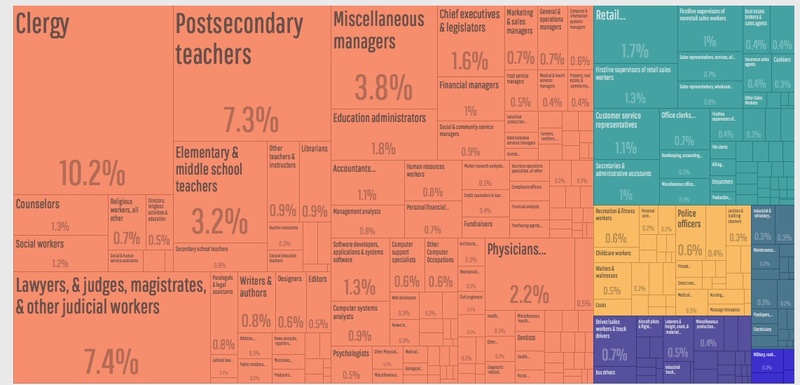Data USA sets a new bar for informing the public through data visualizations
Data USA is live! The powerful open source data visualization platform was developed at the MIT Media Lab with funding and expertise provided by Deloitte. As The Next Web notes, the tool is a gold mine for data nerds. Nation, know thyself.
“Accessible, easy-to-use open government data can have significant economic and societal benefits,” said Dr. Patricia Buckley, director of economics at Deloitte Services LP, in a statement. “Data USA provides the tools to transform data into millions of stories about America — its people, places, industries, occupations, skill sets and educational institutions — to better understand our populations, visualize critical national issues, and improve how we live and work both today and in the future.”
Like Data Viva, which uses the same technology to visualize vast amounts of government data in Brazil, Data USA enables users to instantly visualize open data from government agencies, drilling down into locations, industries or occupations with just a click.
For instance, what does government data say about the District of Columbia? Click over to D.C. and explore what the data can tell us about demographics, housing, education and transit in the nation’s capital.
Data USA is also featuring stories from the data itself, including gender divides in high-paying professions, the relationship of obesity and diabetes or the career prospects for philosophy majors.

Over at Infoworld, editor Eric Knorr called Data USA impressive work, musing that this sort of service is “absolutely essential to democracy.”
He’s right. For most of the public, raw or even refined datasets at Data.gov don’t provide compelling, interesting stories on their own.
“The U.S. government offers almost 200,000 data sets for public use, often out of reach for the average citizen,” said César Hidalgo, professor at the MIT Media Lab and director of Macro Connections, in a statement. “Data USA transforms these datasets into stories, pioneering a new breed of user-friendly government data sites that we urgently need.”
Even though open data is technically accessible, the information or insight it represents is not. As The New York Times reported, the visualization platform makes it easy for the public to sift through data.
Whether government acts as a wholesaler or a retailer for the data — releasing it in bulk for others to analyze or investing in visualizing it on a .gov website — if the public is going to benefit from it, intermediaries need to bake it into apps and services or visualize it.
On that count, Data USA isn’t the first platform to visualize government data, nor is the importance of great visualization a fresh insight (as you know if you’ve been following Sunlight’s work on data visualization and design). Making data accessible and understandable through visualization is one reason OpenGov, Inc. has had success signing up cities to use its own cloud-based financial dataviz platform.
What’s significant about Data USA is the scope of the data it accesses through its API, the speed at which it operates through leveraging D3 and D3plus, and its potential for the future. That last point is particularly true with respect to expanding the realm of the possible for public servants entrusted with stewarding data and disseminating the knowledge locked up in it. Data buried deep on portals or locked up in PDFs is sad data.
“Many government sites require you to navigate through an excessive amount of UI elements, such as drop-downs and search entry fields, before you can access the data you want,” Hidalgo told Co.Design. “The analogy we’re using is they’re like shopping in a supermarket where all the boxes are the same, and you need to open every box to see what’s inside.”
When I talked with the MIT scientist last year about the long-term impact of Data Viva, he told me that his team sees this platform as part of a second wave of open data sites, where government data isn’t just published online but also visualized in interesting, compelling ways. That could be said of Data USA, too.
“To the best of my knowledge, the quality and functionality of the…visualization platform is unparalleled by any effort to open public data,” said Hidalgo. “I would love that its ideas and code base would help lead by example the future redesign of open data portals.”

